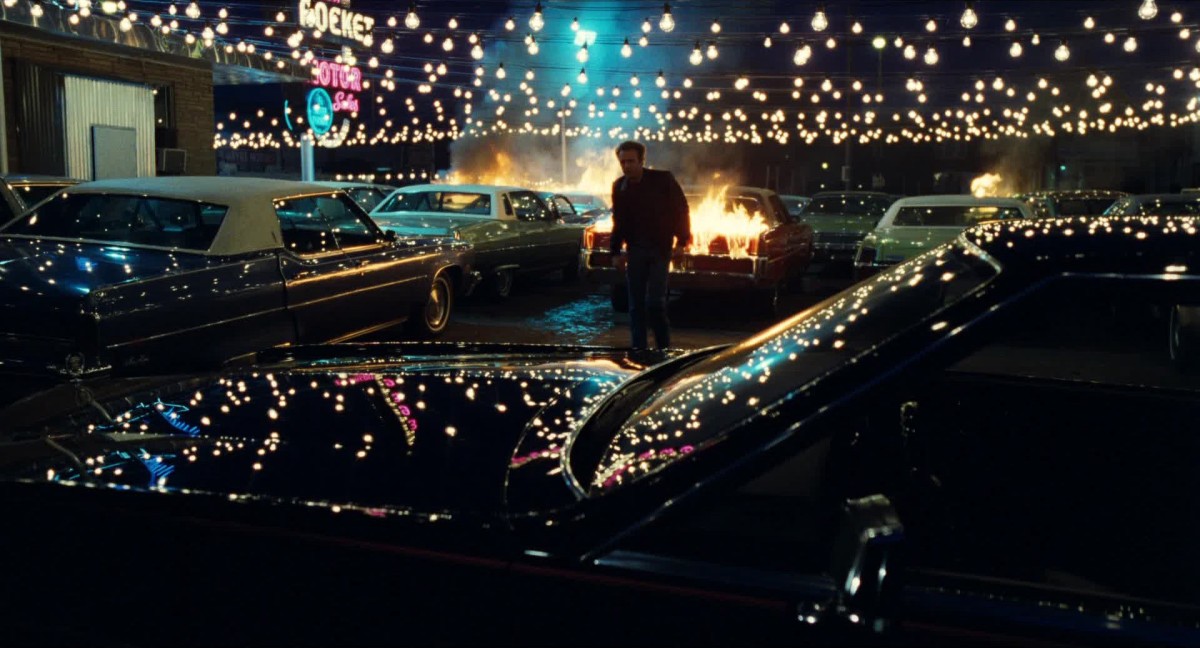Four Stars
Henri Verneuil’s The Sicilian Clan was a large budget affair backed by money from Fox and featuring three of the largest stars of French Cinema at the time—Jean Gabin, Alain Delon, and Lino Ventura. Verneuil (Any Number Can Win, A Monkey in Winter) was a director in the “Tradition of Quality” so despised by the New Wave directors, however he had a reputation for making commercial hits and had worked with all three high profile actors before. As part of the deal with Fox, Verneuil shot English and French versions of the film simultaneously, dubbing dialog for performers uncomfortable delivering lines in English. Upon release, The Sicilian Clan was a reasonable success with American audiences and a massive hit in Europe. While not necessarily as revered as other French or Italian crime pictures, The Sicilian Clan still delivers a tightly crafted, beautifully composed thriller with some serious international star power.
The Sicilian Clan opens with a quote from Anton Chekhov “When I paint horse thieves, I do not say that it is wrong to steal horses. This is the jury’s case and not mine…” Originally a response to critics who accused Chekhov of indifference towards good and evil, presumably Verneuil is making the same case for his film. The protagonists—thieves and killers—will be presented without comment and even their humanity and affections will shine through at times.
The film begins with Roger Sartet (Alain Delon) in custody being charged with the murder of two policemen in a robbery gone haywire. Vittorio Manalese (Jean Gabin) and family disapprove of killing but they are willing to assist Sartet in a slickly orchestrated escape—employing what looks like a surgeon’s bone saw—in exchange for a book of valuable stamps. Lino Ventura’s Comissaire Le Goff is introduced as he engages in some verbal sparring with Sartet at police HQ. Le Goff is tough and driven with an unlit cigarette permanently hanging from his lips because it’s “better than nothing.”
After the initial escape, the pace of things is turned down to a simmer. We get a glimpse into the family dynamics of the Manalese clan. They’re a tight knit bunch with Vittorio as stern patrician. Aldo Manalese’s French wife Jeanne (Irina Demick)—though a competent criminal operative—is somewhat of an outsider. Sartet, cool and defiant, comes to an uneasy agreement to rob a jewelry exhibition with the Manaleses. He also becomes an object of increasing fascination for Jeanne. Le Goff doggedly pursues leads in the hopes to reclaim Sartet and has several tense near misses—aided in part by Sartet’s total inability to lay low.
The initial plan to rob the exhibition gets discarded due to outdated intel and instead becomes a plan to hijack the plane transporting the jewels to their next exhibit in New York. What follows are a series of intricate set-pieces where the gang must kidnap, impersonate, and deceive their way into overtaking the jet bound for New York. The heist is a success, but crime absolutely does not pay in The Sicilian Clan.
There isn’t anything technically mind-blowing about The Sicilian Clan—Vincent Canby called it “a tired example of a tired genre”—but it’s still a “big” feature with a supremely assured style and an intercontinental cool to it. In contrast to cinematographer Henri Decaë’s New Wave work, The Sicilian Clan is mostly not shot on location. Instead you get beautifully constructed sets of airports, restaurants, the pinball warehouse, and a gorgeous toy store in Rome. This does lend a certain artificiality to the film, but it’s also painstakingly shot and composed.
That planning really shines through in the precision action sequences like the opening escape, Sartet evading the police, and the film’s climax. Vernuil’s camera rarely soars but does frame everything perfectly, pushing forward on the action to ramp up the tension. Ennio Morricone’s superb score adds to the overall effect with the catchy main theme and pulse pounding action cues.
Performances by the three leads are functional and professional—much like the skills of their characters—and they are definitely stars on the screen. Honestly, it’s just fun to watch Gabin and Ventura growl at each other. According to both the featurette and the audio commentary included with the Blu-Ray, the character of Jeanne was mostly added and expanded due to Irina Demick being the mistress of producer Darryl Zanuck. However her inclusion came about, it’s a welcome one and her character is certainly pivotal to the film’s conclusion.
The Sicilian Clan is a terrifically engaging, slickly made heist film. This is a studio picture designed to please audiences, but that doesn’t take anything away from the fact that they employed an excellent cast and crew at the height of their talent. Besides the fast action set pieces, the pace may seem plodding at times as the plot uncoils, but that just gives the viewer more time to luxuriate in the set and costume details.
As a set, the Kino Lorber Blu-Ray is excellent. The restoration for both French and English versions look fantastic, with the French being a bit brighter and the English a bit richer. The two versions are actually different films having been shot separately and using slightly different takes—apparently this was a point of contention for Gabin. There isn’t a pronounced difference between the versions, but it is noticeable in cadence with the French being slightly more deliberate and a bit longer. My preference is for the punchier US edit. The featurette is in French and contains interviews with some individuals involved in the production as well as some fun behind the scenes footage. The audio commentary from Howard S. Berger and Nathaniel Thompson is engaging and thorough. Both men have an obvious affection for the film and the period that shines through and they provide valuable context to the production.
At the time of this writing The Sicilian Clan is rentable on a variety of streaming services as well.





